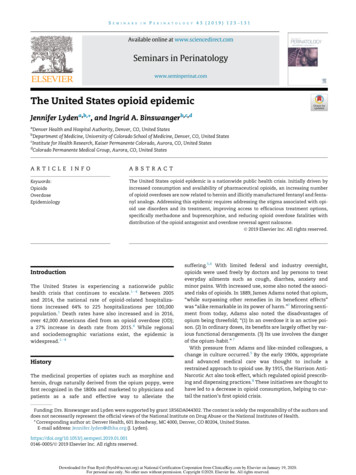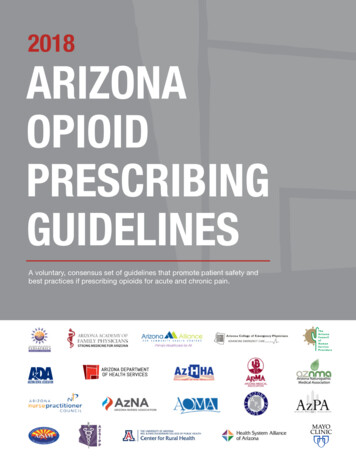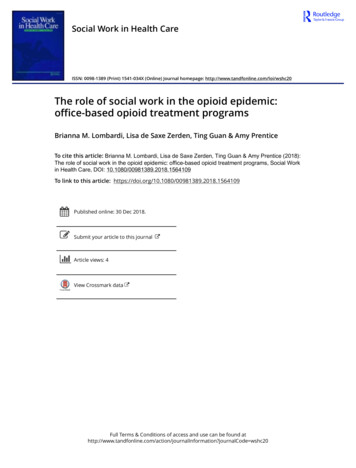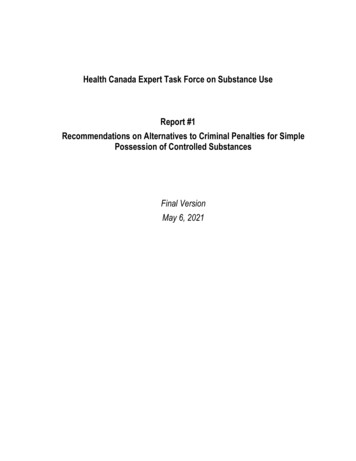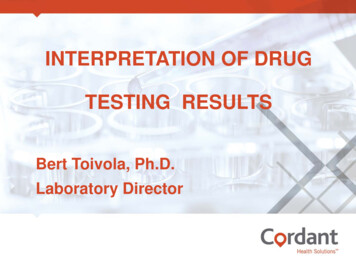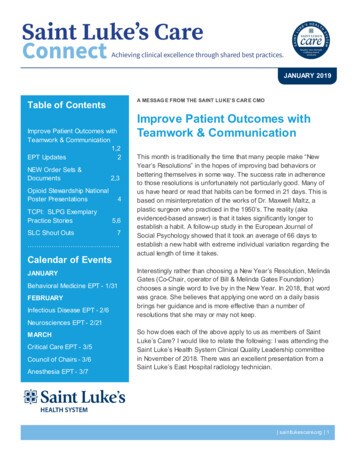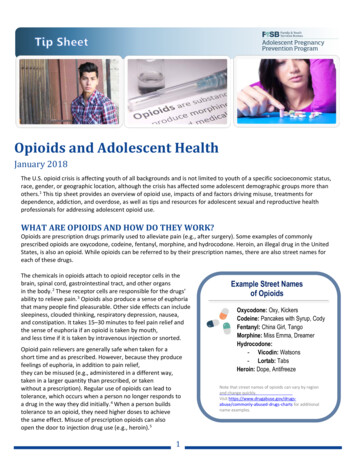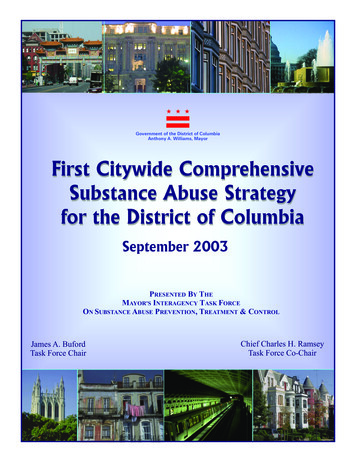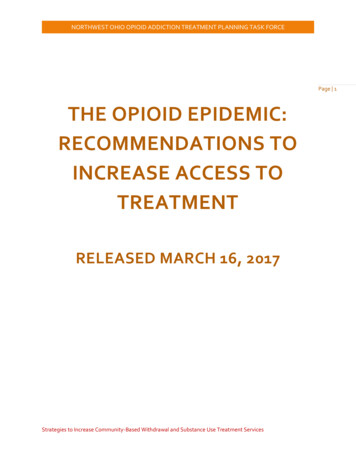
Transcription
NORTHWEST OHIO OPIOID ADDICTION TREATMENT PLANNING TASK FORCEPage 1THE OPIOID EPIDEMIC:RECOMMENDATIONS TOINCREASE ACCESS TOTREATMENTRELEASED MARCH 16, 2017Strategies to Increase Community-Based Withdrawal and Substance Use Treatment Services
NORTHWEST OHIO OPIOID ADDICTION TREATMENT PLANNING TASK FORCETHE OPIOID EPIDEMIC:RECOMMENDATIONS TO INCREASE ACCESS TO TREATMENTMARCH 2017BACKGROUNDThe opioid epidemic’s toll on residents and families is enormous. In 2015, unintentional drugoverdoses caused the deaths of a record 3,050 Ohioans, up from 2,531 in 2014.ii Unintentionaldeaths related to fentanyl, a Schedule II synthetic narcotic that in its prescription form isestimated to be 30 to 50 times more potent than heroin, more than doubled in Ohio from 503in 2014 to 1,155 in 2015.ii Lucas County, the largest county in Northwest Ohio, had the state’seighth highest number of fentanyl-related unintentional overdose deaths in 2015 with 41.iiPrescription opioids are highly available in Northwest Ohio, with oxycodone and Percocet being the most popular in terms of wide-spread illicit use.iii Fentanyl and Dilaudid aredesirable but not easily obtainable, while Vicodin is easy to obtain but not desirable.iii Aprescription opioid addiction often can lead to heroin use.Regionally, from January 2015 through March 2016, there were 11,399 cases of opioid use,abuse, and dependence reported by 18 hospitals in Northwest Ohio.Drug Overdose Death RateThe map on the next page shows the drug overdose death rate for counties throughoutnorthwest Ohio and southeast Michigan.Strategies to Increase Community-Based Withdrawal and Substance Use Treatment ServicesPage 2
NORTHWEST OHIO OPIOID ADDICTION TREATMENT PLANNING TASK FORCEPage 3Ohio Automated Rx Reporting System (OARRS)In response to the growing misuse and diversion of prescription drugs, the State of Ohio Boardof Pharmacy created Ohio’s Prescription Drug Monitoring Program (PDMP), known as theOhio Automated Rx Reporting System (OARRS) in 2006. OARRS collects information on alloutpatient prescriptions for controlled substances dispensed by Ohio-licensed pharmacies andpersonally furnished by licensed prescribers in Ohio. In 2015, there were 81 million fewer opioidsolid doses dispensed to Ohio patients than in 2011, and there were 9.5 million more prescriberqueries in OARRS than in 2011.ii Also, the number of people “doctor shopping” for opioids andother controlled substances decreased from 2,205 in 2011 to 720 in 2015.ii The chart belowStrategies to Increase Community-Based Withdrawal and Substance Use Treatment Services
NORTHWEST OHIO OPIOID ADDICTION TREATMENT PLANNING TASK FORCEcompares several Northwest Ohio counties to the statewide county average for opioid dosesdispensed per Ohio patient from 2010 through the first quarter of 2016.Page 4Comprehensive Addiction and Recovery Act (CARA)Another positive step for addiction treatment occurred in 2016 when Ohio Senator RobPortman’s Comprehensive Addiction and Recovery Act (CARA) was signed into law byPresident Obama. CARA leverages evidence-based law enforcement and healthcare services inresponse to the heroin and opioid epidemic, and key provisions include: Raising the prescribing limit for buprenorphine from 100 to 275 patients, intended togive addicts greater access to buprenorphine, especially in rural areas where fewdoctors are certified to prescribe the drug.Giving prescribing authority for buprenorphine, a medication-assisted addictiontreatment, to trained nurse practitioners and physician assistants.Expanding the availability of naloxone, an overdose reversal drug, to law enforcementagencies and other first responders.Strategies to Increase Community-Based Withdrawal and Substance Use Treatment Services
NORTHWEST OHIO OPIOID ADDICTION TREATMENT PLANNING TASK FORCE Requiring the Veterans Administration to follow opioid prescribing guidelines and putin place stronger oversight and accountability for quality of care; expanding treatmentfor veterans in the criminal justice system because of an addiction.Expanding treatment and family-based services for pregnant women and postpartumwomen struggling with addiction.Ohio House Bill 325Additionally, Ohio House Bill 325 – which has been passed by the Ohio House ofRepresentatives – would require healthcare professionals to encourage pregnant women toenroll in drug treatment programs and the Department of Mental Health and AddictionServices to give priority to treating pregnant women addicted to drugs. The Bill, which is nowin the Ohio Senate Oversight and Reform Committee, would also prohibit public childrenservices agencies from filing an abuse/neglect complaint regarding a newborn solely becausethe mother used a controlled substance while pregnant, if she also enrolled in a drug treatmentprogram before the end of the 20th week of pregnancy and met other conditions. Also, the Billprohibits evidence of the use of a controlled substance obtained through a screening or test todetermine pregnancy or provide prenatal care from being admissible in a criminal proceeding.Access to Addiction Treatment in Northwest OhioIn Northwest Ohio, detoxification services are available at hospitals to stabilize patients in theemergency department or on a medical floor. When the situation is no longer life threatening,there is limited access to the appropriate level of care and treatment. Often, this isexacerbated because the patient is not interested in further treatment and leaves againstmedical advice – and because health insurance does not cover the needed services.The next level of care is sub-acute, which is provided to people in good mental and medicalhealth who are generally more physically stable and committed to a recovery program. InNorthwest Ohio, Zepf Center has a 16-bed unit; Rescue Mental Health & Addiction Serviceshas a 1-2 bed unit designed to be transitional; and Arrowhead Behavioral Health has a 48-bedunit with 34 beds for substance abuse and 14 for psychiatric services. By law, ArrowheadBehavioral Health has been unable to receive Medicaid payments for substance abuse patientsbecause the residential treatment facility has more than 16 beds; the institutions for mentaldiseases (IMD) exclusion is being altered for beneficiaries in Medicaid managed care plansreceiving inpatient treatment for no more than 15 days. In late 2016 and early 2017, fourorganizations announced plans that will result in 64 additional beds in Lucas County. A servicegap exists at the sub-acute level in some counties in Northwest Ohio, including long-termStrategies to Increase Community-Based Withdrawal and Substance Use Treatment ServicesPage 5
NORTHWEST OHIO OPIOID ADDICTION TREATMENT PLANNING TASK FORCEresidential programs, short-term treatment centers and recovery housing. This gap is widenedby payment and legislative barriers. However, in July 2017, Ohio Medicaid is scheduled to adddetoxification per diem to the community benefit plan, room and board costs will still beexcluded.Page 6ABOUT THE TASK FORCEThe Northwest Ohio Opioid Addiction Treatment Planning Task Force was formed bymembers of the Hospital Council of Northwest Ohio in April 2016. The Task Force’s focus is toaddress the lack of access to community-based withdrawal and substance use treatment forresidents who overdose on opioids, one component of a multifaceted strategy to reduce opioidabuse and improve outcomes of those seeking treatment for substance use. Indeed, the lack ofaccess to community-based withdrawal and substance use treatment affects everyone whomisuses any form of alcohol and drugs. In 2015, substance use disorders affected 20.8 millionAmericans nationwide – nearly 8% of the adolescent and adult population and similar to thenumber of people with diabetes.ivThe lack of access to community-based withdrawal and substance use treatment for opioids isa complex local, state and national issue that the Northwest Ohio Opioid Addiction TreatmentPlanning Taskforce investigated and developed this paper to bring light to the issue andpossible solutions that will require a multi-stakeholder response.Task Force MembershipThe Task Force includes representatives from Arrowhead Behavioral Health, Bellevue Hospital,Buckeye Community Health Plan, Firelands Regional Medical Center, Four County ADAMHSBoard (Defiance, Fulton, Henry, Williams), Hancock County ADAMHS Board, HarborBehavioral Health, Hospital Council of Northwest Ohio, Lucas County Correctional TreatmentFacility, Lucas County Mental Health and Recovery Services Board, Lucas County Sheriff,Mercy Health, New Concepts, Paramount, Paulding County Hospital, ProMedica,Sandusky/Seneca/Wyandot ADAMHS Board, University of Toledo, University of ToledoMedical Center, Wood County ADAMHS Board, and Zepf Center. Ohio Representative RobertSprague also participates in the Task Force, as does a member of the recovery community.Strategies to Increase Community-Based Withdrawal and Substance Use Treatment Services
NORTHWEST OHIO OPIOID ADDICTION TREATMENT PLANNING TASK FORCETask Force ProcessThe Task Force met over the course of 2016 and conducted initial research on servicescurrently available and best practices. An assessment was performed of existing withdrawaland treatment programs by county, including types of treatment programs, capacity andPage 7payment sources. Three work groups were formed to consider rules and regulations,reimbursements, and pilot projects to provide Northwest Ohio residents access to communitybased withdrawal and substance use treatment for opioids.To better understand the scope of the problem in Northwest Ohio, eighteen (18) NorthwestOhio hospitals shared data on hospital admissions with opioid use, abuse and dependencediagnoses with the Task Force. This data collection found that in this 18-month period therewere 11,379 diagnoses, and 84% were from Lucas County hospitals. (Please note: One patientmay be represented multiple times in the data.)Northwest Ohio Hospital Admissions January 2015-March 2016DiagnosisNorthwest OhioOutside LucasCountyLucas County35553302Opioid Abuse2,2103701,840Opioid Dependence8,8341,4597,375Opioid UseSource: Northwest Ohio Opioid Addiction Treatment Planning Task ForceNorthwest Ohio Commitment to Evidence-Based TreatmentNorthwest Ohio organizations and providers are committed to providing the best care possiblebased on the Substance Abuse and Mental Health Services Administration’s recommendedTreatment Improvement Protocols. They also are proponents of the American Society ofAddiction Medicine’s national set of criteria for providing outcome-oriented and results-basedcare in the treatment of substance use. These criteria are widely used and comprehensiveguidelines for placement, continued stay and transfer/discharge of patients with substance useand co-occurring conditions.The American Society of Addiction Medicine's treatment criteria create comprehensive andindividualized treatment plans. These treatment plans are developed through amultidimensional patient assessment over five broad levels of treatment that are based on thedegree of direct medical management provided; the structure, safety and security provided;and the intensity of treatment services provided.Strategies to Increase Community-Based Withdrawal and Substance Use Treatment Services
NORTHWEST OHIO OPIOID ADDICTION TREATMENT PLANNING TASK FORCEPage 8Through this strength-based multidimensional assessment, the criteria addresses eachpatient's needs, obstacles and liabilities, as well as strengths, assets, resources and supportstructure.However, it is challenging to implement criteria from the Substance Abuse and Mental HealthServices Administration and the American Society of Addiction Medicine. Barriers include aStrategies to Increase Community-Based Withdrawal and Substance Use Treatment Services
NORTHWEST OHIO OPIOID ADDICTION TREATMENT PLANNING TASK FORCElack of payment for services; regulations that restrict the ability to implement serviceseffectively; and systemic gaps in communications and services along the continuum of care.Northwest Ohio Commitment to a Comprehensive Approach to the Opioid EpidemicWhile the Task Force’s focus is on increasing access to community-based detox and treatment,this is just one component of successfully addressing the opioid issue. The Task Force supportsa comprehensive approach, such as the Strategy to Address Opioid and Heroin Abusedeveloped by Insightformation, Inc. outlined below. The work of this Task Force needs to bepart of a larger systemic approach to reduce opioid misuse and abuse.Strategies to Increase Community-Based Withdrawal and Substance Use Treatment ServicesPage 9
NORTHWEST OHIO OPIOID ADDICTION TREATMENT PLANNING TASK FORCERECOMMENDATIONSIn response to the opioid epidemic, the Northwest Ohio Opioid Addiction Treatment PlanningTask Force recommends the following strategies to increase access to community-basedwithdrawal and substance use treatment services and improve the system of care in NorthwestPage 10Ohio. The Task Force recognizes that withdrawal management and treatment are just twocomponents of the multifaceted strategies that must be implemented to reduce opioid misuseand abuse and improve outcomes of those seeking addiction services. Some of these proposedstrategies will require changes in federal regulations, while others will require systemicchanges and investments to pilot evidence-based programs that could be replicated to scale tocombat the opioid epidemic. Dedicated funding is needed to implement theserecommendations. A main reason these recommendations have not been implemented is thelack of funding for evidence-based treatment and lack of dedicated funding to implement newapproaches in prevention, treatment and systems coordination.TREATMENT ACCESS AND CAPACITY RECOMMENDATIONSAny exposure to treatment should be considered an “opportunity for recovery.” Wheneverpossible, peer support should be provided to increase the opportunity for a positive clinicaloutcome. Treatment success is greatly improved if clients have immediate access to theirassessed level of care. To achieve this, treatment capacity must be increased and madeavailable post withdrawal management to avoid relapse. The following recommendations aredesigned to increase both treatment access and capacity: Maintaining the 2014 expansion of Medicaid eligibility in Ohio – and substance abusetreatment as an essential health benefit – to provide low-income residents access tosubstance abuse treatment.Beginning in 2014, Ohio expanded Medicaid eligibility to include adults with incomebetween 101% and 138% of the federal poverty level. This increased access for lowincome Ohioans to receive healthcare coverage for substance abuse treatment. As aresult, Medicaid enrollees with substance use disorders were more likely to reportimprovement in overall access to care, prescription medication and mental health carethan those enrollees without substance use disorders.v This improvement was evenmore evident for Group VIII (Medicaid expansion) enrollees with an opioid use disorderwho were more likely to report improvements in: overall access to care; access toprescription medications; and access to mental health care.v The improvementmeasured in Ohio is consistent with research indicating improved access to treatmentStrategies to Increase Community-Based Withdrawal and Substance Use Treatment Services
NORTHWEST OHIO OPIOID ADDICTION TREATMENT PLANNING TASK FORCEfor opioid and other substance use disorders because of changes in state and federalhealth policies.vThe Affordable Care Act (ACA) also established 10 mandatory essential health benefits(EHBs) for newly eligible Medicaid enrollees, as well as most individual and small grouphealth plans. Though states have flexibility in determining the details of their EHBs,substance abuse treatment is a required benefit category. ACA also requires applicableplans to comply with the Mental Health Parity and Addiction Equity Act (MHPAEA orthe “Parity Act”). Together, MHPAEA and the ACA will expand behavioral healthcoverage for 62.5 million Americans by 2020 – and allow 32.1 million individuals toaccess substance abuse benefits for the first time.vi They also will expand behavioralhealth coverage for 30.4 million Americans with existing behavioral health benefits.viThe 10 mandatory essential health benefits and Medicaid Expansion are threatened bythe current efforts to repeal and replace the Affordable Care Act. Increasing long-term residential programs, short-term treatment centers andrecovery housing.The availability of options for residential support is imperative to the success oftreatment, especially when the client is not in a supportive home environment. Longterm residential programs provide a supportive, supervised environment; the success ofa short-term treatment center is dependent on connections to care following a stay.Ideally, withdrawal management would be provided in either long- or short-termresidential settings. Otherwise, withdrawal management must be conducted in eitheran inpatient or outpatient setting, with access to medication-assisted treatment ifindicated. In either an inpatient or outpatient setting, however, there is an opportunityfor continuity of care to be compromised.Neither short- nor long-term residential treatment is reimbursed by Medicaid.Typically, a provider bills for the services provided during the residential stay, and thereis a separate charge for room and board typically funded by an ADAMHS Board and/orprivate funding. Additional funding is needed to expand residential programing.Meanwhile, recovery housing is a less staff-intensive alternative and is more successfulfor an individual who has numerous days with negative screens. The benefit of recoveryhousing is the exposure to peers who have similar struggles, successes andopportunities. Recovery housing is also not a reimbursable service. While some modelsare self-sustaining, recovery housing with paid staff requires supplemental funding,Strategies to Increase Community-Based Withdrawal and Substance Use Treatment ServicesPage 11
NORTHWEST OHIO OPIOID ADDICTION TREATMENT PLANNING TASK FORCEtypically from an ADAMHS Board. Increased capacity will require funds for thepurchase/rental of the homes, as well as operational funding. Once capacity exists forrecovery housing, the challenge is retaining individuals in their treatment program andsustaining the funding for the housing and support services.Approximate existing capacity for these services in Northwest Ohio is outlined in thefollowing chart.Residential Treatment and Recovery Housing in Northwest OhioCountyLong-TermResidential BedsShort TermResidential BedsWomen’s BedsMen’s 10Ottawa00010PauldingAccessible bycontract but notlocated in Pauldingfor allPutnamFunded for RecoveryHousing in Dec. 2016000(Researching twobeds)Sandusky0055Seneca00010Source: County ADAMHS Boards Expanding use of medication-assisted treatment, and training family practice groupsand primary care providers to provide management of addictions.There are two primary medications used in the treatment of opiate addiction:Suboxone and Vivitrol. There is limited capacity to provide medication-assistedtreatment in Northwest Ohio and a need to expand the number of physicians willing toprescribe either medication. Medication alone, however, is not recommended;medication-assisted treatment should be coupled with substance use treatmentservices. Increasing the number of private practitioners willing to do the prescribingcould be accomplished through two main options:Strategies to Increase Community-Based Withdrawal and Substance Use Treatment ServicesPage 12
NORTHWEST OHIO OPIOID ADDICTION TREATMENT PLANNING TASK FORCE1. Physicians prescribe the medication from their offices in coordination with asubstance use treatment agency. This could be guided by a memorandum ofunderstanding outlining the procedures that will be followed, including releaseof information, communication/feedback and client participation requirements.2. Private physicians could contract their time on an hourly basis with localtreatment agencies; the treatment agency would pay physicians an hourly rate.Clients would receive services at the contracting agencies, making it easier tocoordinate other needed treatment services.Medication-assisted treatment is reimbursed by Medicaid and private insurance. Belowis a table that outlines the number of physicians and patient capacity available in eachcounty for Suboxone.Prescribing Suboxone in Northwest OhioCounty ADAMHSBoardProvider AgenciesNumber ofPrescribingPhysiciansTotal Numberof PatientsCurrentlyAvailableCentury Health1303A Renewed Mind1705DefianceDoes not pay for SuboxoneErieDoes not pay for SuboxoneHancockHuronDoes not pay for 5Zepf227510*A Renewed Mind25010New Concepts3500250*10 newpatient slotsper weekOttawaDoes not pay for SuboxonePutnamSanduskySeneca000Board does not pay forSuboxone (Dr. Hoy).Working to expand withtwo other physicians11000None000Source: County ADAMHS BoardsStrategies to Increase Community-Based Withdrawal and Substance Use Treatment ServicesPage 13
NORTHWEST OHIO OPIOID ADDICTION TREATMENT PLANNING TASK FORCEBelow is a table that outlines the number of physicians available in each county toprescribe Vivitrol, which is not monitored by the number of patients under treatment.Prescribing Vivitrol in Northwest OhioCounty ADAMHSBoardProvider AgenciesNumber of PrescribingPhysiciansAvailable to ReleasedInmatesBryan Health CenterRecovery Services1YesFirelands1YesCentury Health1YesFirelands1YesOriana House1YesHarbor1YUnison4YUMADAOP1YZeph6YA Renewed Mind3YNew Concepts2YOttawaFirelands1YesPauldingPaulding County Hospital1Upon referral byWestwood BehavioralHealthPutnamPathways CounselingCenter1YesSanduskyFirelands & Oriana House2YesSenecaFirelands & Rigel RecoveryServices2YesDefianceErieHancock3A Renewed MindHuronLucasSource: County ADAMHS Boards Expanding treatment services to the criminal justice population.Jail diversion programs, innovative programs like the Lucas County Sheriff’s Office’sDrug Abuse Response Team (DART), crisis intervention teams for substance use anddrug courts need to be increased in numbers and expanded in capacity. Individualsinvolved with the criminal justice system may interact with the treatment servicessystem at several intercept points. There is opportunity for treatment at each of theseintercepts.Strategies to Increase Community-Based Withdrawal and Substance Use Treatment ServicesPage 14
NORTHWEST OHIO OPIOID ADDICTION TREATMENT PLANNING TASK FORCEThe first intercept is the point of crisis. During any crisis intervention service, there is anopportunity to engage an individual in treatment by completing Screening, BriefIntervention, and Referral to Treatment (SBIRT). SBIRT is an evidence-based practiceused to identify, reduce and prevent problematic use, abuse and dependence onalcohol and illicit drugs.Page 15If the client is placed in jail, the length of stay is often too short for “treatment,” butthere usually is enough time for an inmate to participate in “treatment readiness” and“skills streaming” groups. Both types of groups are designed to help engage the clientinto treatment following release. Many counties have developed Vivitrol protocols,where all the necessary clinical work for medication-assisted treatment is completedwhile an individual is in jail. Upon release, the client can immediately go to a treatmentagency for a Vivitrol shot. Services provided in local jails are not reimbursable by anypayer source. Ideally evidenced-based treatment services would be provided toincarcerated individuals.Drug courts take a public health approach by using a specialized problem-solving modelin which the judiciary, prosecution, defense bar, probation, law enforcement, mentalhealth, social service and treatment communities work together to help addictedoffenders into long-term recovery. If a client is involved with drug court, thecoordination of treatment services is provided by the drug court staff with localtreatment agencies. Compliance with treatment is monitored on a regular basis.Below is a chart that outlines the availability of treatment services at local jails.Treatment Services and Drug Courts in Northwest Ohio Criminal Justice SystemCountyJailTreatment ServicesProvidedAgency ProvidingServicesCCNOYesRecovery ServicesEC DetentionYesFirelandsEC JailYesFirelands & BayshoreHancockHancock CountyJustice CenterYesCentury Health2*HuronCommon PleasMunicipalYesFirelands1YesFirelands1Lucas CountyCorrections CenterYesEmpowered forExcellence, NewConcepts, and ARenewed Mind4-1 Juvenile TreatmentCourt, 1 Family DrugCourt, 2 Lucas CountyDefianceErieLucasNumber of Drug Courts1 Diversion ProgramStrategies to Increase Community-Based Withdrawal and Substance Use Treatment Services
NORTHWEST OHIO OPIOID ADDICTION TREATMENT PLANNING TASK FORCECommon Pleas DrugCourtsOttawaOC Misdeem JailYesFirelands & BayshorePauldingPaulding CountyJailYesWestwood BehavioralHealth1PutnamPutnam CountySheriff’s Dept.YesPathways CounselingCenter0 *(New Common PleasJudge campaigned hewill start a drug ct.)Sandusky CountyJailYesFirelands2YesFirelands0 (working on one)SanduskySenecaSeneca County Jail* Also one Family Dependency Court.Source: County ADAMHS BoardsSYSTEM COORDINATION RECOMMENDATIONSWe cannot only focus on increasing access to treatment to solve the opioid crisis. One activitydid not cause the opioid crisis, and one strategy is not going to solve it. The opioid crisis is amulti-faceted problem which requires a multi-faceted solution. Addressing addiction requires asystems approach. All components of the system – prevention, prescribing guidelines, lawenforcement and treatment – must be coordinated across communities on local, regionalstatewide and national levels. The following recommendations are designed to increasecoordination across Northwest Ohio. Increasing community capacity to address substance abuse comprehensively bydeveloping a regional infrastructure to improve collection, sharing and response tosurveillance data, as well as leveraging prevention, intervention, and treatmentstrategies and programs.To avoid duplication of effort, the Task Force recommends expanding the focus of theNorthwest Ohio Healthcare Emergency Management Coalition (NWO-HEMC), a selfgoverned and voluntary coalition of organizations that provide or support healthservices in the 18 counties of Ohio Homeland Security Region 1, to coordinate opioiduse/overdose data surveillance and response. NWO-HEMC strives to meet the demandfor healthcare services during man-made or natural emergencies, and the coalition isled by a multi-disciplinary steering committee with representatives from public health,emergency management agencies, hospitals and other healthcare partners. Thecoalition is staffed by the Toledo-Lucas County Health Department, the regional publichealth coordination agency, and the Hospital Council of Northwest Ohio, the regionalStrategies to Increase Community-Based Withdrawal and Substance Use Treatment ServicesPage 16
NORTHWEST OHIO OPIOID ADDICTION TREATMENT PLANNING TASK FORCEhealthcare coalition coordination agency. The Northwest Ohio HealthcarePreparedness Committee, comprised of representatives from regional acute carehospitals, specialty hospitals and other healthcare providers, is a standing committee ofNWO-HEMC that meets monthly. NWO-HEMC meets three times a year.Page 17Since opioid overdose outbreaks fall under several disaster preparedness scenarios,including man-made mass casualty incidents, opioid use/overdose is being included as astanding agenda item for both NWO-HEMC and the Northwest Oho HealthcarePreparedness Committee. The regional coalition provides an ongoing forum for sharingbest practices and strategies to increase treatment access and reduce opioid addictionand death rates. The standing agenda item will provide ongoing monitoring of thescope of this issue within Northwest Ohio. Unresolved issues identified through theregional coalition and committee meetings will be documented and communicated toregional and state authorities for further review and consideration. Coalition partnerswill identify data points to measure overdose rates, specific drug types, deaths fromoverdoses, treatment program referrals and placements over time; a task force will beneeded to identify and coordinate the collection of data outcome measures by March2017. Membership can be expanded to include other key stakeholders in addressing theopioid crisis.Additionally, NWO-HEMC could:o Establish a Northwest Ohio Adverse Drug Event Surveillance System since itis difficult to accurately quantify the scope and magnitude of adverse drugevents, as well as to measure access and the unmet need for withdrawal andsubstance use treatment services. Data specific to Northwest Ohio is needed toaccurately quantify the scope of opioid overdose/use within the region;individual data collection efforts exist but are not well coordinated. Regionaldata sources could be used to implement targeted best practices for increasingaccess to treatment and reducing the rates of opioid addiction and deaths. Dataalso could be used to secure additional funding sources to provide ongoingeducation for healthcare providers. A potential resource for regional monitoringand planning is the Prescription Behavioral Surveillance System (PBSS), inwhich Ohio and nine other states participate. The PBSS providesepidemiological analyses of de-identified data from state prescription drugmonitoring programs to target and evaluate interventions aimed at reducingprescription drug abuse and diversion. Startup funds to hire a databaseconsultant and an annual operating budget for a da
Northwest Ohio Hospital Admissions January 2015-March 2016 Diagnosis Northwest Ohio Outside Lucas County Lucas County Opioid Use 355 53 302 Opioid Abuse 2,210 370 1,840 Opioid Dependence 8,834 1,459 7,375 Source: Northwest Ohio Opioid Addiction Treatment Planning Task Force Northwest Ohio Commitment to Evidence-Based Treatment
